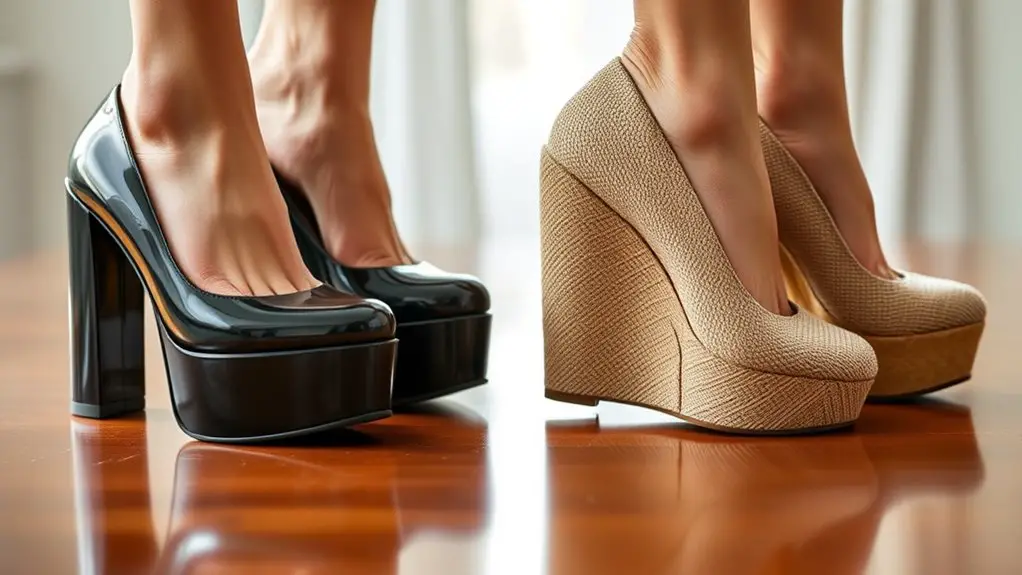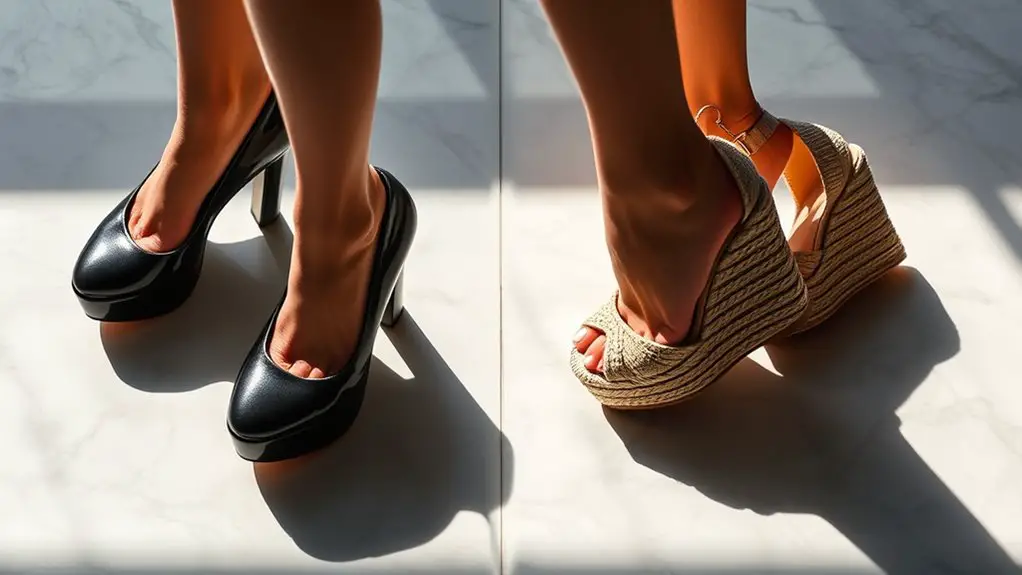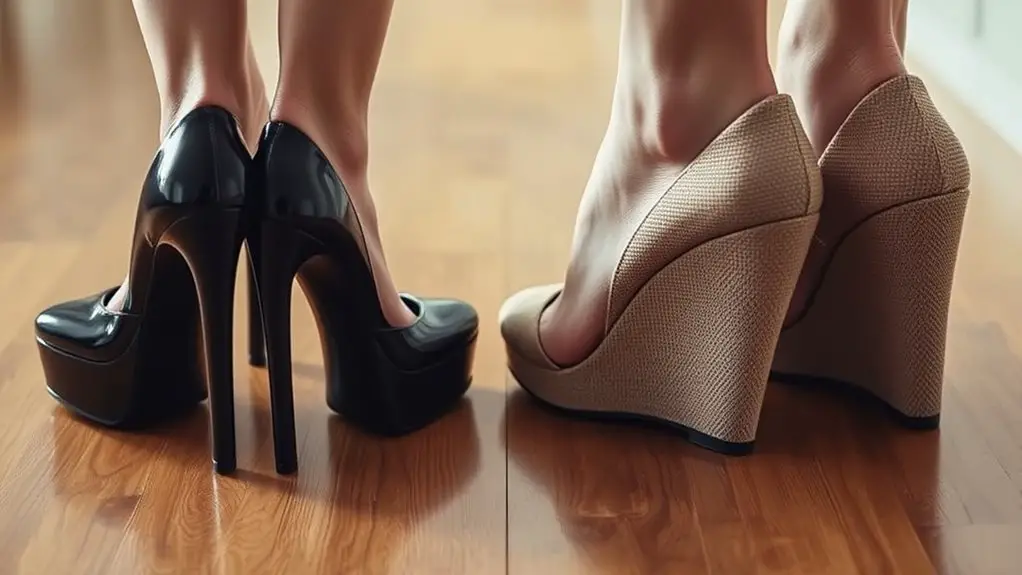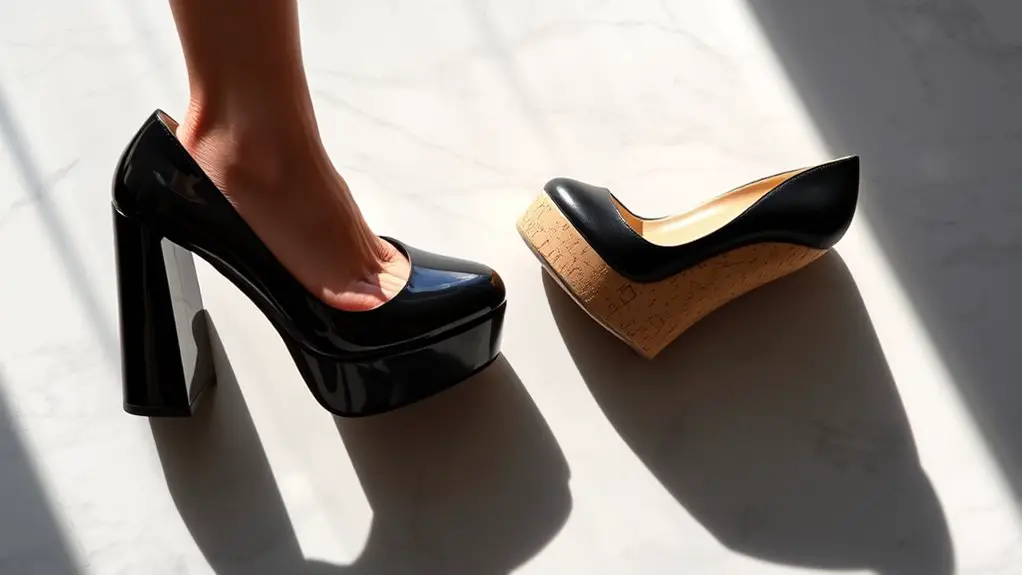When comparing platform heels and wedge heels for support, wedge heels generally provide better benefits due to their design. The solid heel construction distributes weight evenly, enhancing arch support and stability. This design optimizes your balance, especially on uneven surfaces, reducing the risk of rolling your ankle. In contrast, while platform heels offer a uniform height, they may not align your foot as well. For a deeper understanding of each style’s advantages, keep exploring the details.
Understanding Platform Heels

Although platform heels have been a staple in fashion for decades, their unique design sets them apart from other types of footwear. The primary platform heel features include a thick sole that extends throughout the shoe’s length, elevating the heel while providing a level base for the foot. This design reduces the angle of the foot compared to traditional heels, which can lead to increased comfort over extended wear.
When it comes to platform heel materials, you’ll find a variety ranging from wood and cork to synthetic options and leather. Each material influences the shoe’s weight, durability, and aesthetic appeal. For instance, wooden platforms offer a sturdy, retro vibe, while synthetic materials can provide a more modern look. Understanding these aspects of platform heels can help you make informed choices about style, comfort, and functionality, ensuring you select the right pair for your needs.
The Anatomy of Wedge Heels
Wedge heels feature a unique structural design that integrates the sole with the heel, creating a continuous lift from the toe to the back. This design not only enhances stability but also optimizes weight distribution, making them more comfortable for extended wear. Understanding these elements can help you appreciate the functional benefits that wedge heels offer over other styles.
Structural Design Elements
When considering the structural design elements of wedge heels, it is essential to understand their unique composition and how it affects both aesthetics and functionality. Wedge heels typically feature a solid heel construction that extends from the front to the back of the shoe, distributing weight evenly. This design provides enhanced arch support, making them a popular choice for long durations of wear. Here’s a breakdown of key components:
| Component | Description | Impact on Wearer |
|---|---|---|
| Heel Construction | Solid, continuous design | Stability and support |
| Material | Wood, cork, or synthetic | Comfort and flexibility |
| Height | Varies from low to high | Aesthetic versatility |
| Sole Design | Cushioned or flat | Shock absorption |
Understanding these elements can guide your choice effectively.
Weight Distribution Benefits
The unique construction of wedge heels plays a significant role in how weight is distributed across the foot, enhancing overall comfort and stability. Unlike traditional heels, wedge heels provide a solid base that supports the entire foot rather than concentrating pressure on the ball or heel. This even weight distribution promotes better foot alignment, reducing the risk of discomfort and strain. When you wear wedge heels, your body’s weight is more evenly spread, which can help alleviate stress on your joints and muscles. This design allows for a more natural posture, making it easier to walk and stand for longer periods. Ultimately, wedge heels offer a supportive alternative, especially for those seeking both style and comfort.
Comfort Levels: Platform vs. Wedge

While both platform and wedge heels offer a stylish lift, their comfort levels can vary considerably based on design and personal preference. Platform heels typically feature a uniform height across the sole, which can provide a more cushioned experience, especially if they incorporate advanced cushioning technology. This design may reduce pressure on the balls of your feet. However, if arch support isn’t prioritized, you might find them less comfortable for prolonged wear.
On the other hand, wedge heels often provide better arch support due to their design, which can help distribute weight more evenly across your foot. This can lead to a more comfortable fit, particularly if you’re on your feet for extended periods. Ultimately, your choice between platform and wedge heels will depend on how these features align with your comfort needs and personal style preferences.
Stability and Support: A Comparative Analysis
Although both platform and wedge heels can elevate your look, their stability and support differ greatly, impacting how confident you feel while wearing them. Here’s a comparative analysis of their key features:
- Arch Support: Wedge heels generally provide better arch support due to their solid design, allowing for a more natural foot positioning. In contrast, platform heels often lack sufficient arch support, which can lead to discomfort over extended wear.
- Ankle Stability: Wedge heels offer enhanced ankle stability since they distribute weight more evenly across the foot. This design minimizes the risk of rolling an ankle compared to platform heels, which can be less stable because of their height.
- Foot Alignment: The broader base of wedge heels aids in maintaining better foot alignment, reducing strain on the feet and legs. Platform heels may compromise this alignment due to their height and design.
Choosing the right heel type can greatly affect your overall comfort and stability.
Style Versatility: Where Each Heel Shines

How do platform heels and wedge heels fare in the domain of style versatility? Both offer unique advantages in outfit pairings, but their effectiveness can vary depending on the occasion and personal style expressions.
| Heel Type | Best For | Outfit Pairings |
|---|---|---|
| Platform Heels | Dressy events | Cocktail dresses, tailored suits |
| Wedge Heels | Casual outings | Sundresses, shorts, and jeans |
| Both | Versatile occasions | Smart-casual looks |
Platform heels often elevate formal attire, making them ideal for upscale events. Conversely, wedge heels provide a more relaxed aesthetic, perfect for casual gatherings or daytime outings. Understanding these distinctions can help you choose the right heel to complement your wardrobe, ensuring your style expressions align with the event. Therefore, whether you lean towards platforms or wedges, each heel shines in its own right, catering to various fashion needs.
Foot Health Considerations
When considering footwear choices, it’s essential to evaluate the impact of platform and wedge heels on foot health. Both styles can influence foot alignment and overall comfort, but their design features result in different effects on your feet.
- Heel Height: Higher heels can alter your natural foot position, leading to increased pressure on the forefoot. This can contribute to various issues, including pain and misalignment.
- Arch Support: Wedge heels often provide better arch support than platform heels, which can help maintain proper foot alignment during wear.
- Weight Distribution: Platform heels tend to distribute your weight more evenly, but they can also lead to instability. Conversely, wedge heels often offer a more stable base.
Understanding these factors can help you make informed decisions that prioritize your foot health while still achieving the desired aesthetic. Always consider how heel height and design impact your comfort and well-being.
Choosing the Right Heel for Your Occasion
What factors should you consider when choosing the right heel for your occasion? First, think about event suitability. Are you attending a formal gala, a casual brunch, or a night out? Platform heels often offer more height and stability, making them a great choice for longer events where comfort is key, while wedge heels can provide a stylish yet practical option for outdoor occasions.
Next, consider outfit coordination. Your heel choice should complement your ensemble. Platform heels work well with dresses and formal attire, enhancing an elegant look, whereas wedges pair nicely with sundresses or casual outfits, providing a relaxed vibe.
Also, take into account the venue’s environment. If you’ll be on grass or uneven surfaces, wedges might provide better stability. Ultimately, aligning your heel choice with both event suitability and outfit coordination will guarantee you not only look good but feel confident throughout your occasion.
Personal Preferences: What Matters Most
When choosing between platform and wedge heels, your personal preferences play an essential role in the decision-making process. Considerations like comfort level, fashion versatility, and stability can greatly impact your overall experience. By weighing these factors, you can select the heel style that best aligns with your needs and lifestyle.
Comfort Level Considerations
Although both platform heels and wedge heels offer unique aesthetic appeals, comfort is often a decisive factor for many wearers. When it comes to comfort, several key considerations can influence your choice:
- Foot Arch Support: Wedge heels typically provide better arch support, which can alleviate pressure during prolonged wear.
- Cushioning Technology: Many platform heels incorporate advanced cushioning technology, enhancing comfort by absorbing shock and reducing fatigue.
- Weight Distribution: Wedge heels often distribute weight more evenly across the foot, making them feel more stable compared to the more concentrated pressure points found in platform heels.
Ultimately, your personal preferences regarding foot arch, cushioning, and overall weight distribution will greatly impact your comfort level in either style.
Fashion Versatility Factors
While both platform and wedge heels can elevate your style, their versatility in fashion largely depends on personal preferences and the specific occasions for which they’re worn. Consider how each type aligns with current fashion trends and your outfit pairing choices.
| Feature | Platform Heels | Wedge Heels |
|---|---|---|
| Style Options | Bold and trendy | Casual and chic |
| Comfort Level | Varies by design | Generally supportive |
| Occasion Suitability | Night out, parties | Daytime, casual wear |
Ultimately, your decision should reflect your personal style and the settings in which you’ll wear them. Whether you lean towards platforms or wedges, both can adapt to numerous outfits and events, ensuring you look stylish and feel confident.
Stability and Balance Insights
Choosing between platform and wedge heels often hinges on your individual needs for stability and balance. While both options can elevate your style, their support differs based on design and your personal balance techniques. Here are three key considerations:
- Foot Positioning: Wedge heels provide a more stable base due to their continuous surface, enhancing your balance during movement.
- Weight Distribution: Platforms distribute weight evenly across the foot, but may require additional stability training to master.
- Ankle Support: Wedges typically offer better ankle support, essential for maintaining stability, especially on uneven surfaces.
Ultimately, your choice should align with your comfort level and the settings in which you plan to wear these heels, ensuring you prioritize safety and support.
Frequently Asked Questions
Can Platform Heels Be Worn for Long Periods Without Discomfort?
Imagine walking on clouds; that’s what you want with platform heels. Yet, comfort levels vary. If you wear them too long, foot fatigue creeps in. Balance style and wear time to avoid discomfort.
Do Wedge Heels Provide Better Arch Support Than Platform Heels?
When considering wedge comfort, you’ll find that wedge heels often provide better arch alignment compared to platform heels. They distribute weight more evenly, which can lead to less strain on your feet during prolonged wear.
Are Platform Heels Suitable for Outdoor Events?
When considering platform heels for outdoor events, think about outdoor stability and terrain suitability. They may not provide the best grip or support on uneven surfaces, making them less ideal for various outdoor conditions.
How Do I Clean Platform and Wedge Heels Effectively?
To clean platform and wedge heels effectively, use appropriate cleaning techniques based on material care. For leather, a damp cloth suffices; for fabric, a gentle brush may be needed. Always test in an inconspicuous area first.
What Heel Height Is Best for Beginners?
When you’re starting out, a heel height of 1 to 2 inches is your best bet. It offers beginner comfort and heel stability, ensuring you won’t feel like you’re walking on stilts in a circus!



